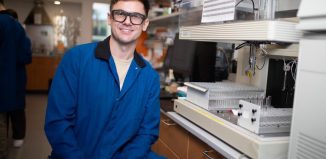CSHL’s Osten looks to understand brain’s wiring
The brain is like an enormous orchestra, as neurological signals from different regions work together to create a symphony of thought, emotion and behavior. When some of those signals are out of tune or come at the wrong time, the melody, and indeed the thought process, can become difficult to follow.
Pavel Osten, an associate professor at Cold Spring Harbor Laboratory, has helped develop ways to compare the signals from mouse brains that are functioning within the range of normal with those that have wiring or signaling problems because of mouse models of disorders like schizophrenia or autism.
“There are disorders linked to brain development that are, in a way, subtle,” he said. “There is nothing dramatically wrong with the brains of patients” on a larger scale. Autism and schizophrenia are likely caused by different wirings of brain connections, without dramatic changes, such as the cell loss in neurodegenerative disorders like Parkinson’s and Alzheimer’s, Osten explained.
To understand what happens in the brains of people with schizophrenia and autism, Osten worked with TissueVision, a Cambridge, Mass., company, to develop an imaging system called serial two-photon tomography. In the past, scientists would take one to two months to image the entire brain at the same resolution that this technique can now do in a day.
It works by integrating automated images of thin parts of the brain, starting with the top. By looking at which regions of a brain are active, scientists can see how the communication among circuits may be disrupted in disease and can look at what drugs might correct these problems.
“When we got to that point, we realized that we have a really good drug-screening method,” he said. This process can map out how drugs affect different regions of the brain.
Indeed, Osten and MIT professor Sebastian Seung started a company called Certerra, which provides a rapid analysis of brain activity at different times. Based at Cold Spring Harbor, the company employs three people. Osten hopes to increase that to 10 to 15 staff members in the next few years.
Osten works one day a week at that company, named for the “territory of the brain,” while he spends the rest of a work week that often exceeds five days in his lab. Osten said tomography can reveal unexpected benefits of drugs by suggesting ways medicines affect the brain.
Many drugs used for depression were “prescribed for something else,” he said. When patients took them, however, they got better. By seeing the effect of a wide range of remedies, researchers can depend “less on serendipity. They can see the clinical effect.”
The CSHL scientist said that seeing which regions of the brain are active doesn’t necessarily reveal every cellular and molecular detail linked to a specific disorder.
“We focus on the large picture,” he explained.
Peter Seeburg, a professor in the Department of Molecular Neurobiology at the Max Planck Institute for Medical Research in Germany, who has known Osten since 1999, described serial two-photon tomography as a “promising way to determine the brain circuitry. Whether it will allow [researchers] to see differences in schizophrenia or autism is at this point unclear.” He explained that the key to its effectiveness lies in the ability to see how the circuitry determined by tomography differed from “normal” individuals which, he contended, was still a “huge amount of work.”
Seeburg described Osten as a driven scientist with an excellent reputation and an international renown, adding, “He has a passion for medically relevant science and a nose for excellent projects.”
A scientist at CSHL for five years, Osten lives in Huntington with his wife, Julia Kuhl, a fine and graphic artist who works part-time at Cold Spring Harbor. The gallery Frosch & Portmann in New York has exhibited her work, which is available at the website www.juliakuhl.com. This year, she had a solo exhibit at the gallery.
The couple, who also have a residence on the lower East Side, enjoy viewing the countryside on Long Island and in the area from their 1967 butternut-yellow Camaro Convertible.
Osten, who grew up in Czechoslovakia, is pleased with his decision to join Cold Spring Harbor Laboratory, where he feels the collaborations with colleagues in the neuroscience department make it a “pretty spectacular place to work.”






